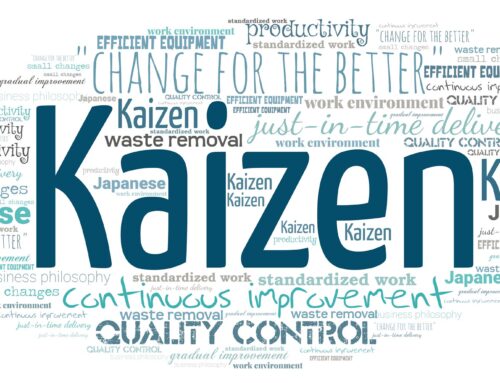The most successful organizations, in any industry, are continually working to improve their processes and become more efficient. To achieve these results, there are a variety of methodologies to work with. One of the most impactful of these is called Lean Six Sigma.
What is Lean Six Sigma? Today we’ll be taking an in-depth look at its philosophy, its implementation, and how it can help streamline your business.

What is Lean Six Sigma?
So just what is Lean Six Sigma, exactly?
While it may sound like something out of a Tom Clancy novel, Lean Six Sigma is actually a combination of two different approaches: Lean methodology and Six Sigma methodology. The result is an approach that strives to eliminate waste and improve efficiency, with a focus on quality.
We’ll start our discussion by breaking down the two methodologies from which Lean Six Sigma is composed.
Lean
In the 1940’s, Japanese automaker Toyota was looking for ways to improve their manufacturing processes. Their goal was to eliminate wasteful steps and improve efficiency. The founders of Toyota, who pioneered this methodology, identified seven types of waste (or “muda” in Japanese) that would hinder the success of their company.
The result was the creation of the Lean methodology, revolutionizing the manufacturing process. Lean is all about “cutting the fluff,” and eliminating unnecessary steps that cause waste. Any steps or processes that do not ultimately create value for the customer, are considered wasteful.
However, Lean isn’t relegated solely to manufacturing processes. Today, many technology companies and other industries make use of the Lean methodology to reduce waste and continually improve their processes.
Six Sigma
Six Sigma is a methodology originally developed by Motorola in the 1980s to achieve consistency and quality in their manufacturing process.
The name “Six Sigma” is derived from the Greek letter Sigma, which is used in statistics to represent standard deviation. In manufacturing, it essentially means how close a product is to an ideal “perfect” state. In technical terms, to state that a product is “six sigma,” means that there are only 3.4 defects per million opportunities.
Achieving Six Sigma is considered an extremely high indicator of quality and consistency in manufacturing or any other measurable industry.
Lean Six Sigma
This brings us back to our subject, Lean Six Sigma. Lean Six Sigma combines the efficiency of Lean methodology with the precision of Six Sigma.
Both processes are aimed at delivering a consistent customer experience. The result is a comprehensive approach that delivers efficiency and quality not only in manufacturing, but in a diverse set of industries such as healthcare, finance, retail, and even government.
How Lean Six Sigma Works
To understand how the entire Lean Six Sigma process works, we’ll dissect the principles of each component.
Lean Principles
At its core, Lean methodology is all about eliminating waste.
The process starts by identifying what the customer wants or values from the product. From this starting place, areas of waste can be identified.
Today, the Lean process has been adapted to an acronym known as DOWNTIME. The DOWNTIME framework is invaluable in minimizing waste and streamlining an endless variety of processes.
Here is how the DOWNTIME concept is used to curtail waste.
Defects
Defects are anything that requires correction in a system. This step identifies any defects, errors, or mistakes as the first step in improving quality.
Overproduction
When companies produce more than they need, they create waste, which leads to increased cost. The Lean methodology stresses the importance of producing only what is necessary, when it is necessary.
Waiting
Waiting for one process to finish before beginning another creates idle time, where nothing is being produced. Whether it’s having the right information, materials, or anything else needed to take the next step, reducing wait time is a key component of an efficient process.
Non-Utilized Talent
Companies that do not utilize the full breadth of knowledge and skills their employees possess are guilty of waste. Empowering employees is key to improving processes.
Transportation
Moving products from place to place consumes great resources. Transportation must be minimized until it is absolutely necessary, in order to keep costs low.
Inventory
A key focus of Lean is keeping inventory on hand, without unnecessary surplus. Too much inventory takes up space and requires more transportation, two common causes of waste.
Motion
Moving people, teams, equipment, and materials around without need is a form of waste that can lead to errors and potential injury.
Extra-Processing
Doing more work than necessary is a huge contributor to waste issues. Steps to accomplish a goal should be minimized. If something does not add value to the process or customer, strike it.
Six Sigma Principles
The Six Sigma methodology is all about creating quality for customers by striving for near perfection in the production of goods and services. It employs its own framework, DMAIC, for identifying quality issues:
Define – The first step in Six Sigma is used to develop a clear understanding of the problem, or determine opportunities for improvement. Project goals are set in this stage, and stakeholders are identified.
Measure – This phase establishes a baseline – where performance is at currently. Key metrics must be identified so data can be collected.
Analyze – With the baseline data in hand, statistical analysis is used to identify the causes of defects in the process.
Improve – This phase focuses on discovering solutions based on the data accumulated. Testing is done to validate proposed solutions.
Control – The final phase is intended to maintain the solution over time. Continual monitoring of metrics is crucial to preventing a recurrence of the defect(s).
Benefits of Lean Six Sigma
When combined, the methodologies of Lean and Six Sigma form a powerful tool that helps companies identify and solve problems of waste and quality control. Some of the most important benefits of Lean Six Sigma are:
Improved Efficiency
The principles of Lean Six Sigma are designed to minimize waste by eliminating unnecessary steps. A focus on eliminating waste will also naturally increase productivity, creating more value for businesses that adopt the model. Every step of the production process should have the goal of creating value for the customer. If it does not, it should be eliminated.
Enhanced Quality
In addition to eliminating waste, the Lean Six Sigma methodology is all about achieving a consistent product or service. This methodology is designed to identify defects and errors using data, and create standards of control to minimize defects. The result is an extremely high degree of consistency and quality.
Cost Savings
By focusing on eliminating various forms of waste, such as overproduction and unnecessary transportation of resources and products, cost and expenditures are kept under control. Whether human or material, effective management of resources is key to reducing cost.
Customer Satisfaction
Adopting Lean Six Sigma practices has a direct impact on customer satisfaction. By keeping the customer’s needs front and center, and consistently delivering reliable, high-quality goods and services, customers are more likely to become loyal to the product, brand, or organization.
Implementation of Lean Six Sigma
It’s clear that adopting Lean Six Sigma in your organization has a variety of benefits. But how do you get started implementing these philosophies in your organization?
At Manex, we have worked with numerous organizations to bring the Lean Six Sigma methodology to their daily operations.
In our experience, these aspects are required to implement the Lean Six Sigma methodology in an organization.
A Commitment From Leadership
When Toyota initially developed the Lean methodology, the impetus came from the founders of the organization themselves. And like Toyota, it will take a complete investment in the ideals of waste reduction and commitment to quality to adopt Lean Sigma Six.
When leaders are committed to excellence, they create a culture of continuous improvement that cascades down throughout the organization.
Employee Training
With management on board, comprehensive training can begin for your workforce.
To become Lean Six Sigma certified, your team will need to acquire a variety of skills, denoted by a series of “belts,” or levels:
White Belt – The beginner level is where a basic understanding of Lean Six Sigma is taught.
Yellow Belt – Has an understanding of the basics and may be a team member of a Lean Six Sigma project.
Green Belt – An intermediate level, Green Belts, may lead small projects, and assist higher-level belts in larger projects
Black Belt – An advanced level, Black Belts, require a high degree of knowledge in Lean Six Sigma tools and methods. They are project leaders, with lower levels reporting to them.
Master Black Belt – The highest level, Master Black Belt, is reserved for experts on Lean Six Sigma methods. They shape organizational strategy and mentor Black Belts.
Project Selection
Determining where to begin with Lean Six Sigma can seem like a daunting challenge. Choosing a project to implement should be based on the potential impact to your business goals, as well as customer impact – how the changes will benefit your customers. Other factors like resource availability and overall feasibility will determine where to focus your efforts.
Conclusion
Adopting the philosophy of Lean Six Sigma has the potential to transform nearly any business. By streamlining your processes and focusing on delivering consistent high-quality products, you will increase your overall profit, while improving customer satisfaction.
When you’re ready to take the next step, consider Manex as your partner in Lean Six Sigma implementation.
Our consultants are Six Sigma Black Belt certified and can lead the implementation of Lean Six Sigma in your organization. Our experienced team will help you select the right areas to focus your efforts, to maximize the impact of Lean Six Sigma on your organization.
Contact Manex today at [email protected] to get your business on the road to becoming Lean Six Sigma certified.


